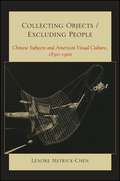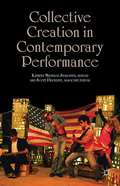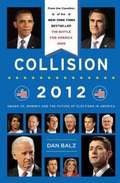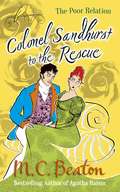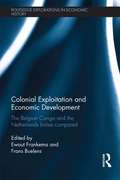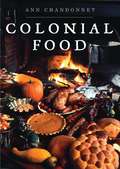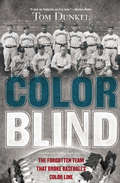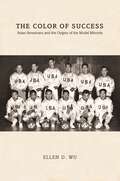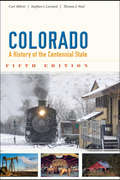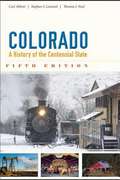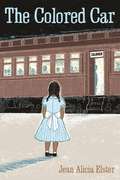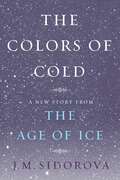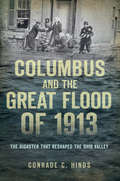- Table View
- List View
Collected Papers on English Legal History
by Sir John BakerOver the last forty years, Sir John Baker has written on most aspects of English legal history, and this collection of his writings includes many papers that have been widely cited. Providing points of reference and foundations for further research, the papers cover the legal profession, the inns of court and chancery, legal education, legal institutions, legal literature, legal antiquities, public law and individual liberty, criminal justice, private law (including contract, tort and restitution) and legal history in general. An introduction traces the development of some of the research represented by the papers, and cross-references and new endnotes have been added. A full bibliography of the author's works is also included.
Collecting Objects / Excluding People: Chinese Subjects and American Visual Culture, 1830-1900
by Lenore Metrick-ChenIn Collecting Objects / Excluding People, Lenore Metrick-Chen demonstrates an unknown impact of Chinese immigration upon nineteenth-century American art and visual culture. The American ideas of "Chineseness" ranged from a negative portrayal to an admiring one and these varied images had an effect on museum art collections and advertising images. They brought new ideas into American art theory, anticipating twentieth-century Modernism. Metrick-Chen shows that efforts to construct a cultural democracy led to the creation of unforeseen new categories for visual objects and unanticipated social changes. Collecting Objects / Excluding People reveals the power of images upon culture, the influence of media representation upon the lives of Chinese immigrants, and the impact of political ideology upon the definition of art itself.
Collective Creation in Contemporary Performance
by Kathryn SyssoyevaThis edited volume situates its contemporary practice in the tradition which emerged at the beginning of the twentieth century. Collective Creation in Contemporary Performance examines collective and devised theatre practices internationally and demonstrates the prevalence, breadth, and significance of modern collective creation.
The Collector of Lost Things
by Jeremy PageThe year is 1845 and young researcher Eliot Saxby is paid to go on an expedition to the Arctic in the hope of finding remains of the by now extinct Great Auk.He joins a hunting ship, but the crew and the passengers are not what they seem. Caught in the web of relationships on board, Eliot struggles to understand the motivations of the sociopathic Captain Sykes; the silent first mate, French; the flamboyant laudanum-addicted Bletchley; and most importantly of all, Bletchley's beautiful but strange "cousin" Clara.As the ship moves further and further into the wilds of the Arctic Sea, Eliot clings to what he believes in, desperate to save Clara but drawn irrevocably back into the past that haunts him.
The Collector of Lost Things
by Jeremy PageI felt the worlds of ocean and ice were meeting in a frontier of rage, as if the Earth had torn in two along this line.This was a place if there ever was a place, where you could disappear.The year is 1845 and young researcher Eliot Saxby is paid to go on an expedition to the Arctic in the hope of finding remains of the by now extinct Great Auk. He joins a regular hunting ship, but the crew and the passengers are not what they seem. Caught in the web of relationships on board, Eliot struggles to understand the motivations of the sociopathic, embroidery-loving Captain Sykes, the silent First Mate French, the flamboyant laudanum-addicted Bletchley and, most importantly of all, Bletchley's beautiful but strange 'cousin' Clara. As the ship moves further and further into the wilds of the Arctic sea, Eliot clings to what he believes in, desperate to save Clara but drawn irrevocably back into the past that haunts him.The first historical novel from an author who has been critically acclaimed for his two contemporary novels (Salt and The Wake), The Collector of Lost Things is a compulsive, beautifully writtten read.
The Collector of Lost Things
by Jeremy PageI felt the worlds of ocean and ice were meeting in a frontier of rage, as if the Earth had torn in two along this line.This was a place if there ever was a place, where you could disappear.The year is 1845 and young researcher Eliot Saxby is paid to go on an expedition to the Arctic in the hope of finding remains of the by now extinct Great Auk. He joins a regular hunting ship, but the crew and the passengers are not what they seem. Caught in the web of relationships on board, Eliot struggles to understand the motivations of the sociopathic, embroidery-loving Captain Sykes, the silent First Mate French, the flamboyant laudanum-addicted Bletchley and, most importantly of all, Bletchley's beautiful but strange 'cousin' Clara. As the ship moves further and further into the wilds of the Arctic sea, Eliot clings to what he believes in, desperate to save Clara but drawn irrevocably back into the past that haunts him.The first historical novel from an author who has been critically acclaimed for his two contemporary novels (Salt and The Wake), The Collector of Lost Things is a compulsive, beautifully writtten read.
The Collector of Lost Things
by Jeremy PageThe worlds of ocean and ice were meeting in a frontier of rage, as if the Earth had torn in two along this line. This was a place, if there ever was a place, where you could disappear.The year is 1845 and young researcher Eliot Saxby is paid to go on an expedition to the Arctic in the hope of finding remains of the by now extinct Great Auk. He joins a regular hunting ship, but the crew and the passengers are not what they seem. Caught in the web of relationships on board, Eliot struggles to understand the motivations of the sociopathic, embroidery-loving Captain Sykes, the silent First Mate French, the flamboyant laudanum-addicted Bletchley and, most importantly of all, Bletchley's beautiful but strange 'cousin' Clara. As the ship moves further and further into the wilds of the Arctic sea, Eliot clings to what he believes in, desperate to save Clara but drawn irrevocably back into the past that haunts him.
Collision 2012
by Dan BalzDan Balz, longtime Washington Post correspondent and bestselling coauthor of The Battle for America 2008, presents an inside view and analysis of the Obama-Romney presidential race.
Collision of Empires: Italy's Invasion of Ethiopia and its International Impact
by G. Bruce StrangItaly's invasion of Ethiopia in 1935 marked a turning point in interwar Europe. The last great European colonial conquest in Africa, the conflict represented an enormous gamble for the Fascist dictator Benito Mussolini. He faced a challenge not only from a stout Ethiopian defence, but also from difficult logistics made worse by the League of Nations' half-hearted sanctions. Mussolini faced down this opposition, and Italian troops, aided by air superiority and liberal use of yprite gas, conquered Addis Ababa within eight months, a victory that shocked many military observers of the time with its speed and suddenness. The invasion had enormous repercussions on European international relations. In the midst of a national election campaign, the British National Government had felt constrained to support the League, despite fears that sanctions through the League could lead to war with Italy. The concentration of the Royal Navy in the Mediterranean Sea alienated Mussolini and placed the French government on the horns of dilemma; should France support its military partner, Italy, or its more important potential ally, Great Britain? French attempts to mark out a middle ground did little to placate the Duce, and the crisis seemed to develop a deep rift between Fascist Italy and the Anglo-French democracies, while at the same time creating a crisis in Anglo-French relations. Mussolini turned towards Nazi Germany in an attempt to end his diplomatic isolation during the sanctions episode, although Hitler considered the Duce's friendship a mixed blessing. The question of American adherence to sanctions increased ill will between British politicians and the Roosevelt administration in Washington, as each tended to blame the other for the failure of oil sanctions and the collapse of collective security. The international crisis posed similarly thorny problems for the smaller powers of Europe, and for Japan and the Soviet Union. The crisis impeded common defence against Fascist expansionism while giving impetus to claims of the revisionist powers. Despite the tremendous importance of the international crisis, however, little new work on the subject has appeared in recent decades. In this volume, an international cast of contributors take a fresh look at the crisis through the lens of new evidence and new approaches to international relations history to provide the most comprehensive coverage of the crisis currently possible, and their work provides new frames of reference for exploring imperialism, collective security and genocide.
Colonel Sandhurst to the Rescue (The Poor Relation)
by M.C. BeatonA case of mistaken identity is transformed into a case of true love!As usual, the poor relations are in need of money to finance the hotel and this time it is up to Colonel Sandhurst to come to the rescue. After coming across Sir Randolph's daughter Frederica, who is running away to escape an awful marriage to Lord Bewley, the Colonel devises a plan to force Sir Randolph to settle his six month outstanding hotel bill and save Frederica from her terrible fate.The clever plan is thwarted when Lord Bewley shows up at the drop point instead of Sir Randolph, and the poor relations must make a deal with Lord Bewley in order to get their money... and keep Colonel Sandhurst out of gaol!
Colonial America: A Very Short Introduction (Very Short Introductions)
by Alan TaylorIn the traditional narrative of American colonial history, early European settlements, as well as native peoples and African slaves, were treated in passing as unfortunate aberrations in a fundamentally upbeat story of Englishmen becoming freer and more prosperous by colonizing an abundant continent of "free land." <p><p> Over the last generation, historians have broadened our understanding of colonial America by adopting both a trans-Atlantic and a trans-continental perspective, examining the interplay of Europe, Africa, and the Americas through the flow of goods, people, plants, animals, capital, and ideas. In this Very Short Introduction, Alan Taylor presents an engaging overview of the best of this new scholarship. He shows that American colonization derived from a global expansion of European exploration and commerce that began in the fifteenth century. The English had to share the stage with the French, Spanish, Dutch, and Russians, each of whom created alternative Americas. By comparing the diverse colonies of rival empires, Taylor recovers what was truly distinctive about the English enterprise in North America. He focuses especially on slavery as central to the economy, culture, and political thought of the colonists and restores the importance of native peoples to the colonial story. To adapt to the new land, the colonists needed the expertise, guidance, alliance, and trade of the Indians who dominated the interior. This historical approach emphasizes the ability of the diverse natives to adapt to the newcomers and to compel concessions from them. <p> This Very Short Introduction describes an intermingling of cultures and of microbes, plants, and animals--from different continents that was unparalleled in global history.
Colonial Exploitation and Economic Development: The Belgian Congo and the Netherlands Indies Compared (Routledge Explorations in Economic History)
by Ewout Frankema Frans BuelensSince many countries in the world at present were European colonies in the not so distant past, the relationship between colonial institutions and development outcomes is a key topic of study across many disciplines. This edited volume, from a leading international group of scholars, discusses the comparative legacy of colonial rule in the Netherlands Indies and Belgian Congo during the nineteenth and twentieth centuries. Whereas the Indonesian economy progressed rapidly during the last three decades of the twentieth century and became a self-reliant and assertive world power, the Congo regressed into a state of political chaos and endemic violence. To which extent do the different legacies of Dutch and Belgian rule explain these different development outcomes, if they do at all? By discussing the comparative features and development of Dutch and Belgian rule, the book aims to 1) to contribute to a deeper understanding of the role of colonial institutional legacies in long run patterns of economic divergence in the modern era; 2) to fill in a huge gap in the comparative colonial historical literature, which focuses largely on the comparative evolution of the British, French, Spanish and Portuguese Empires; 3) to add a focused and well-motivated comparative case-study to the increasing strand of literature analyzing the marked differences in economic and political development in Asia and Africa during the postcolonial era. Covering such issues as agriculture, manufacturing and foreign investment, human capital, fiscal policy, labour coercion and mineral resource management, this book offers a highly original and scholarly contribution to the literature on colonial history and development economics.
Colonial Food
by Ann ChandonnetOf the one hundred Pilgrims who settled at Plymouth in 1620, nearly half had died within months of hardship, starvation or disease. One of the colony's most urgent challenges was to find ways to grow and prepare food in the harsh, unfamiliar climate of the New World. From the meager subsistence of the earliest days and the crucial help provided by Native Americans, to the first Thanksgiving celebrations and the increasingly sophisticated fare served in inns and taverns, this book provides a window onto daily life in Colonial America. It shows how European methods and cuisine were adapted to include native agriculture such as maize, potatoes, beans, peanuts and tomatoes, and features a section of authentic menus and recipes, including apple tansey and crab soup, which can be used to prepare your own colonial meals.
Coloniality, Religion, and the Law in the Early Iberian World
by Santa Arias Raul Marrero-FenteFrom postcolonial, interdisciplinary, and transnational perspectives, this collection of original essays looks at the experience of Spain's empire in the Atlantic and the Pacific and its cultural production.Hispanic Issues SeriesNicholas Spadaccini, Editor-in-ChiefHispanic Issues Onlinehispanicissues.umn.edu/online_main.html
Coloniality, Religion, and the Law in the Early Iberian World (Hispanic Issues)
by Santa Arias and Raúl Marrero-FenteFrom postcolonial, interdisciplinary, and transnational perspectives, this collection of original essays looks at the experience of Spain's empire in the Atlantic and the Pacific and its cultural production.Hispanic Issues Series Nicholas Spadaccini, Editor-in-ChiefHispanic Issues Online hispanicissues.umn.edu/online_main.html
Color Blind: The Forgotten Team That Broke Baseball's Color Line
by Tom DunkelA 2013 CASEY Award Finalist for Best Baseball Book of the YearWhen baseball swept America in the years after the Civil War, independent, semipro, and municipal leagues sprouted up everywhere. With civic pride on the line, rivalries were fierce and teams often signed ringers to play alongside the town dentist, insurance salesman, and teen prodigy. In drought-stricken Bismarck, North Dakota during the Great Depression, one of the most improbable teams in the history of baseball was assembled by one of the sport’s most unlikely champions. A decade before Jackie Robinson broke into the Major Leagues, car dealer Neil Churchill signed the best players he could find, regardless of race, and fielded an integrated squad that took on all comers in spectacular fashion.Color Blind immerses the reader in the wild and wonderful world of early independent baseball, with its tough competition and its novelty. Dunkel traces the rise of the Bismarck squad, focusing on the 1935 season and the first National Semipro Tournament. This is an entertaining, must-read for anyone interested in the history of baseball."A tale as fantastic as it is true.”-Boston Globe
The Color of Success: Asian Americans and the Origins of the Model Minority (Politics and Society in Modern America #119)
by Ellen D. WuThe Color of Success tells of the astonishing transformation of Asians in the United States from the "yellow peril" to "model minorities"--peoples distinct from the white majority but lauded as well-assimilated, upwardly mobile, and exemplars of traditional family values--in the middle decades of the twentieth century. As Ellen Wu shows, liberals argued for the acceptance of these immigrant communities into the national fold, charging that the failure of America to live in accordance with its democratic ideals endangered the country's aspirations to world leadership. Weaving together myriad perspectives, Wu provides an unprecedented view of racial reform and the contradictions of national belonging in the civil rights era. She highlights the contests for power and authority within Japanese and Chinese America alongside the designs of those external to these populations, including government officials, social scientists, journalists, and others. And she demonstrates that the invention of the model minority took place in multiple arenas, such as battles over zoot suiters leaving wartime internment camps, the juvenile delinquency panic of the 1950s, Hawaii statehood, and the African American freedom movement. Together, these illuminate the impact of foreign relations on the domestic racial order and how the nation accepted Asians as legitimate citizens while continuing to perceive them as indelible outsiders. By charting the emergence of the model minority stereotype, The Color of Success reveals that this far-reaching, politically charged process continues to have profound implications for how Americans understand race, opportunity, and nationhood.
Colorado: A History of the Centennial State, Fifth Edition
by Carl Abbott Stephen J. Leonard Thomas J. NoelSince 1976, newcomers and natives alike have learned about the rich history of the magnificent place they call home from Colorado: A History of the Centennial State. In the fifth edition, coauthors Carl Abbott, Stephen J. Leonard, and Thomas J. Noel incorporate recent events, scholarship, and insights about the state in an accessible volume that general readers and students will enjoy. The new edition tells of conflicts, shifting alliances, and changing ways of life as Hispanic, European, and African American settlers flooded into a region that was already home to Native Americans. Providing a balanced treatment of the entire state’s history—from Grand Junction to Lamar and from Trinidad to Craig—the authors also reveal how Denver and its surrounding communities developed and gained influence. While continuing to elucidate the significant impact of mining, agriculture, manufacturing, and tourism on Colorado, the fifth edition broadens and focuses its coverage by consolidating material on Native Americans into one chapter and adding a new chapter on sports history. The authors also expand their discussion of the twentieth century with updated sections on the environment, economy, politics, and recent cultural conflicts. New illustrations, updated statistics, and an extensive bibliography including Internet resources enhance this edition.
Colorado
by Carl AbbottSince 1976, newcomers and natives alike have learned about the rich history of the magnificent place they call home from Colorado: A History of the Centennial State. In the fifth edition, coauthors Carl Abbott, Stephen J. Leonard, and Thomas J. Noel incorporate recent events, scholarship, and insights about the state in an accessible volume that general readers and students will enjoy. The new edition tells of conflicts, shifting alliances, and changing ways of life as Hispanic, European, and African American settlers flooded into a region that was already home to Native Americans. Providing a balanced treatment of the entire state's history--from Grand Junction to Lamar and from Trinidad to Craig--the authors also reveal how Denver and its surrounding communities developed and gained influence.While continuing to elucidate the significant impact of mining, agriculture, manufacturing, and tourism on Colorado, the fifth edition broadens and focuses its coverage by consolidating material on Native Americans into one chapter and adding a new chapter on sports history. The authors also expand their discussion of the twentieth century with updated sections on the environment, economy, politics, and recent cultural conflicts. New illustrations, updated statistics, and an extensive bibliography including Internet resources enhance this edition.
Colorado Courtship
by Cheryl St. John Debra UllrickWinter of Dreams by Cheryl St. JohnIf Violet Kristofferson had known that her new employer was the town undertaker, she might never have come to Carson Springs as his cook. Yet she needs a fresh start away from scandal. And Ben Charles's unflinching faith could be her path to something truly precious-a new family.The Rancher's Sweetheart by Debra UllrickThe cowboys on her uncle's ranch show Sunny Weston no respect-except for foreman Jed Cooper. A riding and roping contest is Sunny's chance to prove herself. But now that she's falling for Jed, will she find courage to take the biggest risk of all, and trust her heart?
Colorado Forts: Historic Outposts on the Wild Frontier
by Jolie Anderson GallagherThroughout the 1800s, explorers braved brutal weather and hostile enemies, trekking through the towering mountains and fertile valleys on the ragged edge of civilization. These early pioneers built stockades, trading posts, military camps and miniature citadels that would shape the state of Colorado for generations to come. As the settlers struggled to survive desperate times, economic depressions and bloody wars, some of these historic outposts would become Colorado's cities, schools, hospitals and museums, while others would sink back into the mud from which they came. Join author Jolie Anderson Gallagher as she chronicles the stories of the forts and the early explorers, fur trappers, soldiers and wives who constructed and occupied them.
The Colored Car
by Jean Alicia ElsterIn The Colored Car, Jean Alicia Elster, author of the award-winning Who's Jim Hines?, follows another member of the Ford family coming of age in Depression-era Detroit. In the hot summer of 1937, twelve-year-old Patsy takes care of her three younger sisters and helps her mother put up fresh fruits and vegetables in the family's summer kitchen, adjacent to the wood yard that her father, Douglas Ford, owns. Times are tough, and Patsy's mother, May Ford, helps neighborhood families by sharing the food that she preserves. But May's decision to take a break from canning to take her daughters for a visit to their grandmother's home in Clarksville, Tennessee, sets in motion a series of events that prove to be life-changing for Patsy. After boarding the first-class train car at Michigan Central Station in Detroit and riding comfortably to Cincinnati, Patsy is shocked when her family is led from their seats to change cars. In the dirty, cramped "colored car," Patsy finds that the life she has known in Detroit is very different from life down south, and she can hardly get the experience out of her mind when she returns home-like the soot stain on her finely made dress or the smear on the quilt squares her grandmother taught her to sew. As summer wears on, Patsy must find a way to understand her experience in the colored car and also deal with the more subtle injustices that her family faces in Detroit. By the end of the story, Patsy will never see the world in the same way that she did before. Elster's engaging narrative illustrates the personal impact of segregation and discrimination and reveals powerful glimpses of everyday life in 1930s Detroit. For young readers interested in American history, The Colored Car is engrossing and informative reading.
The Colors of Cold: A New Story from The Age of Ice
by J. M. SidorovaA stunning new ebook original story by J. M. Sidorova Includes an exclusive excerpt of Sidorova's acclaimed debut novel, The Age of Ice.Speculative fiction icon John Crowley calls J. M. Sidorova's The Age of Ice "marvelous." Karen Joy Fowler, author of The Jane Austen Book Club, hails it as "everything you could want in a novel." Now, in this special ebook-only story, Sidorova returns to the world of The Age of Ice--her captivating blend of fiction, history, and fantasy--offering a mesmerizing new tale of the power of cold. In April 1814, just days after Napoléon's defeat by the coalition of the European powers, Prince Alexander Velitzyn, the hero of The Age of Ice, is drifting around Paris, coming to grips with the brutality of the war and his role in it. Unbeknownst to him, Alexander strolls through the same passageways as another human being just like him. Hidden behind costume and makeup, twenty-two-year-old Cherie performs a daily show in the Palais-Royal, a noble palace where shopkeepers and showgirls have set up all manner of risqué commerce--boutiques, gambling rooms, and pubs designed to satiate every desire of the senses. Cherie, though, is an unusual act. Her feat relies on physics, not trickery. She is a young woman making do with the fate she's been dealt--not just the terror of revolution, but her own, crippling coldness. Then, one evening, a wounded young soldier named Julien comes to her room, and what happens threatens to upend Cherie's notion of the world and herself. The Colors of Cold is a beautifully imagined glimpse into two lives trapped by frost--metaphorical and literal--set amid one of the most stirring moments in the history of Paris.
Columbia Food: A History of Cuisine in the Famously Hot City (American Palate)
by Laura AboyanEating is a pleasure in the South Carolina capital these days, thanks to chefs, farmers and artisanal purveyors who feed an insatiable hunger for anything fresh, local and delicious. Columbia offers a bounty for enthusiasts--places like the urban farm City Roots, the all-local farmers' market Soda City and the array of community supported agriculture options. For exquisite dining, the city's options are as variable as its influences. The locally focused menu at Terra, the intense and alluring ambiance at Rosso, the vegetarian-inspired fare at Rosewood's Market Deli and the flair of self-taught chef Ricky Mollohan give the city a unique palate. Grab a reservation with author Laura Aboyan as she details the delectable history of Columbia cuisine.
Columbus and the Great Flood of 1913: The Disaster that Reshaped the Ohio Valley (Disaster)
by Conrade C. HindsBeginning on Easter Sunday, March 23, 1913, Columbus and the Ohio Valley endured a downpour that would produce the largest flood in one hundred years. Heavy rains came on the heels of an especially cold winter, resulting in a torrent of runoff over saturated and frozen ground. Rivers and streams quickly overflowed and levees failed, sending tsunami-like floodwater into unsuspecting communities and claiming four hundred lives. There were ninety-six deaths in Columbus alone when the swollen Scioto River emptied water that ran nine to seventeen feet deep through the streets of the near west side. Join Conrade C. Hinds and the Columbus Landmarks Foundation in a closer look at a flood disaster that reshaped the American Midwest.

